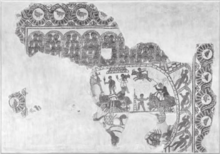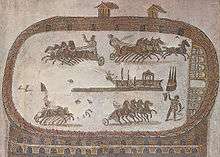Circus of Carthage

The Circus of Carthage is a Roman circus in Carthage, in present-day Tunisia. Used for chariot racing, it was modelled on the Circus Maximus in Rome and other circus buildings throughout the empire. Measuring more than 470 m in length and 30 m in width,[1] it could house up to 45,000 spectators.
History
There is no consensus about the circus's dating, as it was built and used for several years before its official dedication. It seems to have been built sometime around 238 AD. The people of the city of Carthage joined together in the circus to overcome the stresses of their lives. "Altogether, to go to the circus in a time of crisis was not to succumb to luxury but to show a robust, civic patriotism. To love one's city was to love the games. Salvian reports that as the Vandal armies closed in around the governmental capitals of Africa- first Cirta (Constantine, Algeria) in Numidida and then Carthage- they were met by "the sound of the people as it roared acclamations in the circus"[2]

Circus of Carthage Design

A brief description of the Circus of Carthage based on the mosaic found in Bardo National Museum (Tunis): " It is the only mosaic to show both the interior of the arena and the exterior façade, which has two arcades separated by a cornice. There also is an awning over the seats, which continue over the carceres, conveying more the appearance of an amphitheater than a circus. The two temple-like structures above the seating are novel, as well, and may be situated at the break and finish lines."[3] [4]
Building Usage
The Circus Maximus as well as other Circus' and later amphitheatres were used for "glatorial fights with wild beasts and other scenes of butchery."[5]
Building Materials
Remains from the Circus Maximus, specifically the spina (a dividing barrier) was put into the Circus of Carthage, as well as the Circus of Maxentius and the city of Vienne located in France. These remains of the spina are marble. [5]
References
- ↑ Humphrey, J.H. (1986). Roman Circuses: Arenas for Chariot Racing. University of California Press. p. 446. ISBN 9780520049215. Retrieved 2015-08-14.
- ↑ Brown, Peter (2013-09-02). Through the Eye of a Needle: Wealth, the Fall of Rome, and the Making of Christianity in the West, 350-550 AD. Princeton University Press. ISBN 1400844533.
- ↑ http://penelope.uchicago.edu/~grout/encyclopaedia_romana/circusmaximus/carthage.html
- ↑ Mosaïques de Tunisie (1976) by Georges Fradier and André Martin; Roman Circuses: Arenas for Chariot Racing (1986) by John H. Humphrey.
- 1 2 https://books.google.com/books?id=RacKAAAAIAAJ&pg=PA354&lpg=PA354&dq=circus+of+carthage&source=bl&ots=5Nf6v6fTrd&sig=J015kF59D1u3VO_USEx-GZVSn2w&hl=en&sa=X&ved=0ahUKEwiY5_zevMjJAhXE1h4KHR8pA5QQ6AEIUjAK#v=onepage&q=circus%20of%20carthage&f=false
| Wikimedia Commons has media related to Ancient Roman circus of Carthage. |
Coordinates: 36°51′03″N 10°18′49″E / 36.8508°N 10.3137°E